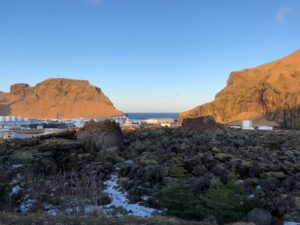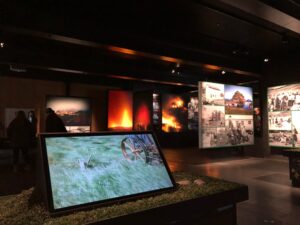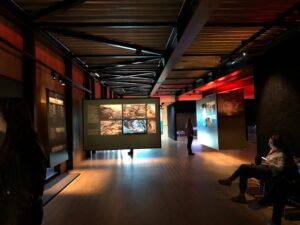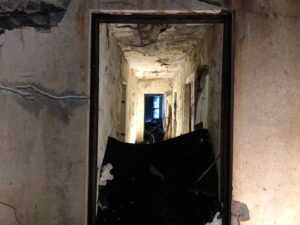January 17th was our first day on Heimaey in Vestmannaeyjar (Westman Islands). One of the strongest tourism attractions to this island is the puffin colonies in the summer. However, this island is much more than simply that; in 1973, the Eldfell volcano erupted, lasting about 6 months until the lava cooled and the dust settled. Unfortunately, a significant portion of the town was forever buried. When Heimaey was safe to return to, not all residents came back, as many of whom had lost their homes forever.

After the eruption and aftermath, returning and former residents wondered if the homes and businesses we’re truly buried forever. A lot of what had been buried was under meters of volcanic ash; a material that, in theory, could easily be moved with the right equipment. In 2005, they began excavating the ash in order to uncover what was lost in history so many years ago. Through the excavations, they found a house. And another. And another one after that. There was one house in particular, Gerthisbraut 10, that remained in better shape; many of the items the family had left behind were still intact inside, as well as the structure of the house itself.
In 2014, a museum opened to the public on the excavated mound of volcanic ash. This museum educates guests on how cruel nature can be, and what the residents experienced in 1973. The new museum was built around the excavated Gerthisbraut 10 house, a similar structure design to what we saw in the Settlement museum in Reyjkavík. The residents of Heimaey are very proud of this museum, because it allows for the stories of their elders to exist into the future.

The museum also has an exhibit on another volcanic activity occurring nearby; the creation of the island of Surtqsey, and other oceanic floor rising nearby. The island of Surtsey emerged from the ocean floor a decade before the destructive eruption on Heimaey. Surtsey is under UNESCO’s protection from human intrusion, allowing the new landmass to grow and change completely naturally. This is an experiment monitoring how ecosystems develop over time; animals, plants, and marine organisms on and around the island are allowed to grow in population, and adapt and change to this newly formed environment.

What made this museum so special was the physical, real house at the center of the museum that had been buried for many years. The former owner of this house, Gerthur Sigurthardóttir, was involved in the making of this museum; many of the stories of her and her family experiencing the eruption that fateful night are recorded in a audio guide around the museum. In the picture below, through that hallway, Gerthur and her husband were able to see the erupting volcano, illuminating the sky in the night.

She recounts that she and her husband quickly escaped danger. In the documentary, Gerthur was the first person to explore the buried house, before the construction of the museum. She did not want any item uncovered in the house, except for the calcized doorknob that had been the last thing her husband had touched as they realized they would never again return to their house as it once was.
For further information on this museum, please visit their website: http://eldheimar.is
Leave a Reply
You must be logged in to post a comment.